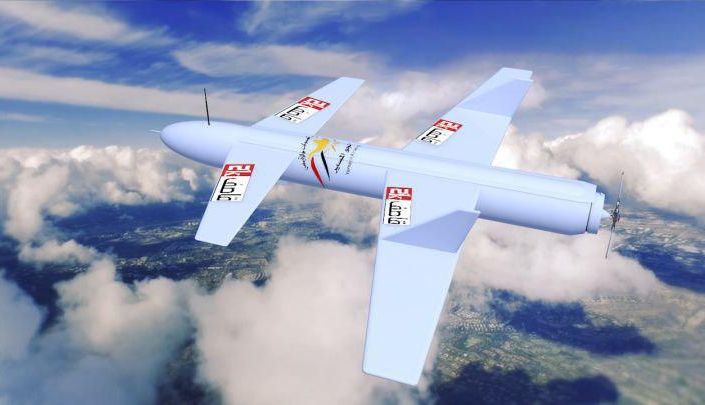www.aljazeerah.info
Opinion Editorials, September 2019
Archives
Mission & Name
Conflict Terminology
Editorials
Gaza Holocaust
Gulf War
Isdood
Islam
News
News Photos
Opinion Editorials
US Foreign Policy (Dr. El-Najjar's Articles)
www.aljazeerah.info
US in Talks with Houthi Rebels to End Bloody Yemen War By Abdus Sattar Ghazali Al-Jazeerah, CCUN, September 10, 2019 |
 |
 |
|
|
Yemeni drone, Qasif-2K used in attacking Saudi targets, file,
September 10, 2019 |
A high ranking US official said Thursday (Sept 5) that Washington was in talks with the Houthi rebels in a bid to end Yemen's war.
“We are narrowly focused on trying to end the war in Yemen,” US Assistant Secretary of State for Near Eastern Affairs David Schenker told reporters during a visit to Al-Kharj air base near the Saudi capital Riyadh.
“We are also having talks to the extent possible with the Houthis to try and find a mutually acceptable negotiated solution to the conflict.”
Schenker gave no further details on the talks, which mark a renewed effort to end a complex conflict that has left tens of thousands dead and sparked what the United Nations labels the world’s worst humanitarian crisis.
The Wall Street Journal reported last month that Washington was preparing for direct talks with the rebels and that its negotiating team would be led by Christopher Henzel, who became the Trump administration’s first ambassador to Yemen in April.
A State Department official said Thursday that “the US ambassador to Yemen and other US diplomats talk to all Yemenis to further US objectives in the country.” “We are focused on supporting a comprehensive political agreement that will end the conflict,” the official said.
The rebels, for their part, have exposed the limits of Saudi Arabia’s military might, menacing its cities with what Riyadh says are Iranian-supplied weapons.
“The Houthis have been sending a barrage of drones and ballistic missiles towards vital Saudi installations after a recent spike in US-Iran tensions,” Fatima Abo Alasrar, a scholar at the Washington-based Middle East Institute, told AFP.
At the Al-Kharj air base, Schenker was shown a display of what Saudi officials said were fragments of missiles and unmanned drones intercepted in recent months.
String of attacks in Saudi Arabia claimed by Houthis
Caleb Weiss of the Long War Journal said Yemen’s Houthi insurgent movement has steadily increased its capabilities to strike inside Saudi Arabia utilizing a myriad of weapons and tools, many of them newly announced, as these recent attacks demonstrate.
Over the past few days, Yemen’s Houthi insurgents claimed a series of attacks inside Saudi Arabia. These include ballistic and cruise missiles, as well as drone strikes.
Beginning on Aug. 24, the Houthis said its forces conducted two drone strikes on the King Khaled airbase in Khamis Mushayt and the Abha airport in southern Saudi Arabia. A day later, another round of drone strikes were reported on both targets.
On the same day, ten Badr-1 ballistic missiles were reportedly fired into Saudi’s Jizan city. However, Saudi officials reported that the country’s air defense systems shot down six ballistic missiles. The officials did not confirm if more missiles were included in the barrage.
On Aug. 26, another ballistic missile, the newly-announced Nakal missile, was reportedly fired at Saudi troops near Najran. Later in the day, another round of drones were reportedly intercepted near the King Khaled airbase in Khamis Mushayt.
As drones were hitting the King Khaled airbase, a separate attack was purportedly occurring near Riyadh with the new Samad-3 suicide drones. If confirmed, this marks the second time Houthi drones have hit the Saudi capital. The first was a reported strike on an Aramco facility near the capital last month.
On Aug. 27, the Houthis showcased another newly-announced ballistic missile, the Qasem-1, by allegedly hitting Saudi troops positioned near the Yemeni border in Najran. Another drone was intercepted and destroyed by Saudi forces over Khamis Mushayt as well.
And on August 28, a new cruise missile, the Quds-1, was launched towards the Abha airport. Though, Saudi officials stated that the missile was intercepted and destroyed.
UN Report on Yemen: US, UK accomplices to atrocities
In what is considered the deadliest airstrike of the year, Saudi-led forces bombed a detention facility in the western city of Dhamar in Western Yemen, killing about 100 people on Sunday (Sept 1). The prison was under control of the Houthi rebels.
The deadly bombing in the Yemen took place shortly before the United Nations Human Rights Council released a report on Tuesday, which condemned US, French and British complicity in the atrocities being committed by Saudi Arabia and its allies in Yemen.
The 274-page report says that there are "reasonable grounds to believe that the parties to the conflict in Yemen are responsible for an array of human rights violations and violations of international humanitarian law. Some of these violations are likely to amount to war crimes."
“The inhumane deprivation of the Yemeni population of their rights to medicine, water and food should stop immediately. The very survival of the 24 million in need should be the first priority”, added Jendoubi. Mr. Kamel Jendoubi, chairperson of the Group of Experts on Yemen.
The Group expressed strong concern that the parties to the conflict may have used starvation as a method of warfare, as these acts contributed to depriving the population of objects indispensable to its survival.
The Yemen war death toll is five times higher than we think
Patrick Cockburn wrote in The Independent newspaper of UK that one reason Saudi Arabia and its allies are able to avoid a public outcry over their intervention in the war in Yemen, is that the number of people killed in the fighting has been vastly understated. The figure is regularly reported as 10,000 dead in three-and-a-half years, a mysteriously low figure given the ferocity of the conflict.
Now a count by a non-partisan group has produced a study demonstrating 56,000 people have been killed in Yemen since early 2016. The number is increasing by more than 2,000 per month as fighting intensifies around the Red Sea port of Hodeidah. It does not include those dying of malnutrition, or diseases such as cholera.
“We estimate the number killed to be 56,000 civilians and combatants between January 2016 and October 2018,” says Andrea Carboni, who researches Yemen for the Armed Conflict Location and Event Data Project (ACLED), an independent group formerly associated with the University of Sussex that studies conflicts and is focusing attention on the real casualty level. He told me he expects a total of between 70,000 and 80,000 victims, when he completes research into the casualties, hitherto uncounted, who died between the start of the Saudi-led intervention in the Yemen civil war, in March 2015, and the end of that year.
The oft-cited figure of 10,000 dead comes from a UN official speaking only of civilians in early 2017, and has remained static since. This out of date statistic, drawn from Yemen’s patchy and war-damaged health system, has enabled Saudi Arabia and the UAE – who lead a coalition of states strongly backed by the US, UK and France – to ignore or downplay the loss of life.
Loss of life from fighting should be easier to record and publicise, and the fact this has not happened in Yemen is a sign of the lack of interest by the international community in the conflict. Carboni says ACLED has been able to tally the number of civilians and combatants killed in ground fighting and bombing by drawing on the Yemeni press and, to a lesser extent, international media. ACLED has used these sources, after carefully assessing their credibility, to calculate the number of fatalities. Where figures differ, the group uses lower estimates and favours the claims of those who suffered casualties, over those who say they inflicted them.
It is difficult to distinguish between civilian targets that are deliberately attacked, and non-combatants who died because they were caught in the crossfire, or were close to a military unit or facility when hit.
A study by Professor Martha Mundy – Strategies of the Coalition in the Yemen War: Aerial Bombardment and Food War – concludes the Saudi-led bombing campaign deliberately targeted food production and storage facilities. Some 220 fishing boats have been destroyed on Yemen’s Red Sea coast and the fish catch is down by half.
Almost all those who died are Yemenis, though the figures also include 1,000 Sudanese troops killed fighting on behalf of the Saudi coalition.
The true “butcher’s bill” in the Yemen war has taken too long to emerge, but it may help to increase pressure on outside powers to stop the killing.
Who are Houthis?
David William Pear, a Senior Editor for OpEdNews, argues that there was a popular uprising led by the Houthi Movement in 2011 that deposed the 33-year dictatorship of Ali Abdullah Saleh. The United Nations then facilitated negotiations for an interim government until national elections could be held. A nationwide referendum was held on the UN peace plan in 2012. Only one name was on the ballot for the interim president. It was the name of the US and the Kingdom of Saudi Arabia backed Abdrabbuh Mansour Hadi. Not surprisingly he got 100% of the votes cast. His term in office was 2 years.
Instead of helping to form a unity government and prepare for elections in 2014, Hadi went on an International Monetary Fund imposed austerity program and a rapid privatization program. He went on a spree of an unauthorized massive sell off of state-owned enterprises at fire sale prices. The purchasers were outside Gulf States and US buyers. In 2014 Hadi illegally extended his presidency for another year, saying he needed more time. He increased the austerity program on Yemenis and intensified the privatizations.
The people of Yemen said they had enough of Hadi. Under the leadership of the Northern group known as Houthis there were massive demonstrations in the capital city of Sana'a and demands for Hadi's resignation. Hadi resigned and fled the capital city of Sana'a. He went to the Southern port city of Aden, rescinded his resignation, and tried to reconstitute his failed government. Failing that, he fled to Saudi Arabia.
Not surprisingly, As'ad AbuKhalil, Professor of Political science at California State Stanislaus, told Greg Wilpert of The Real News Network, if you go to WikiLeaks, the Houthis is an own Indigenous movement in South Yemen. They have their own agenda. They did not have any regional ambitions or even associations.
Abdus Sattar Ghazali is the Chief Editor of the Journal of America.
***
Share the link of this article with your facebook friends
|
|
|
|
||
|
||||||


